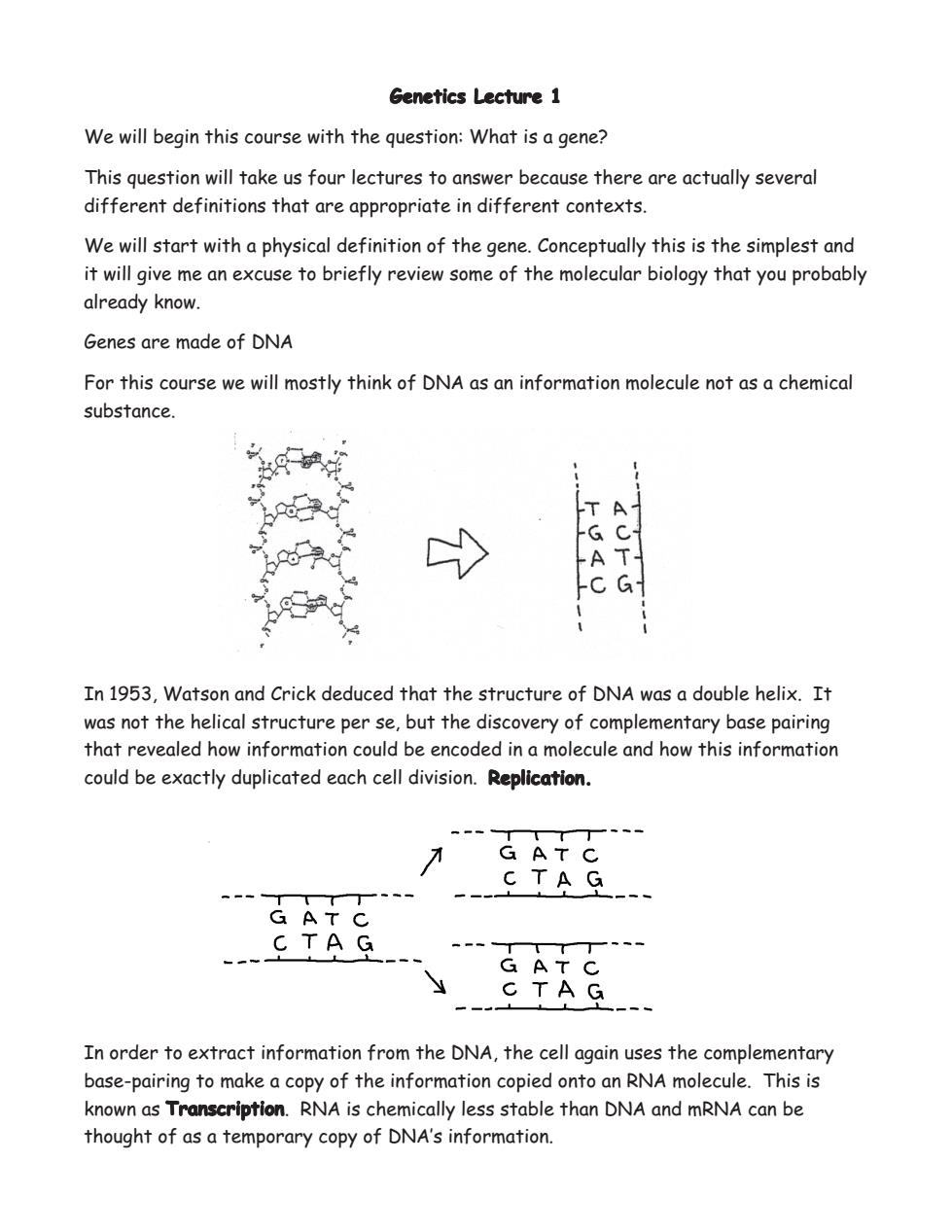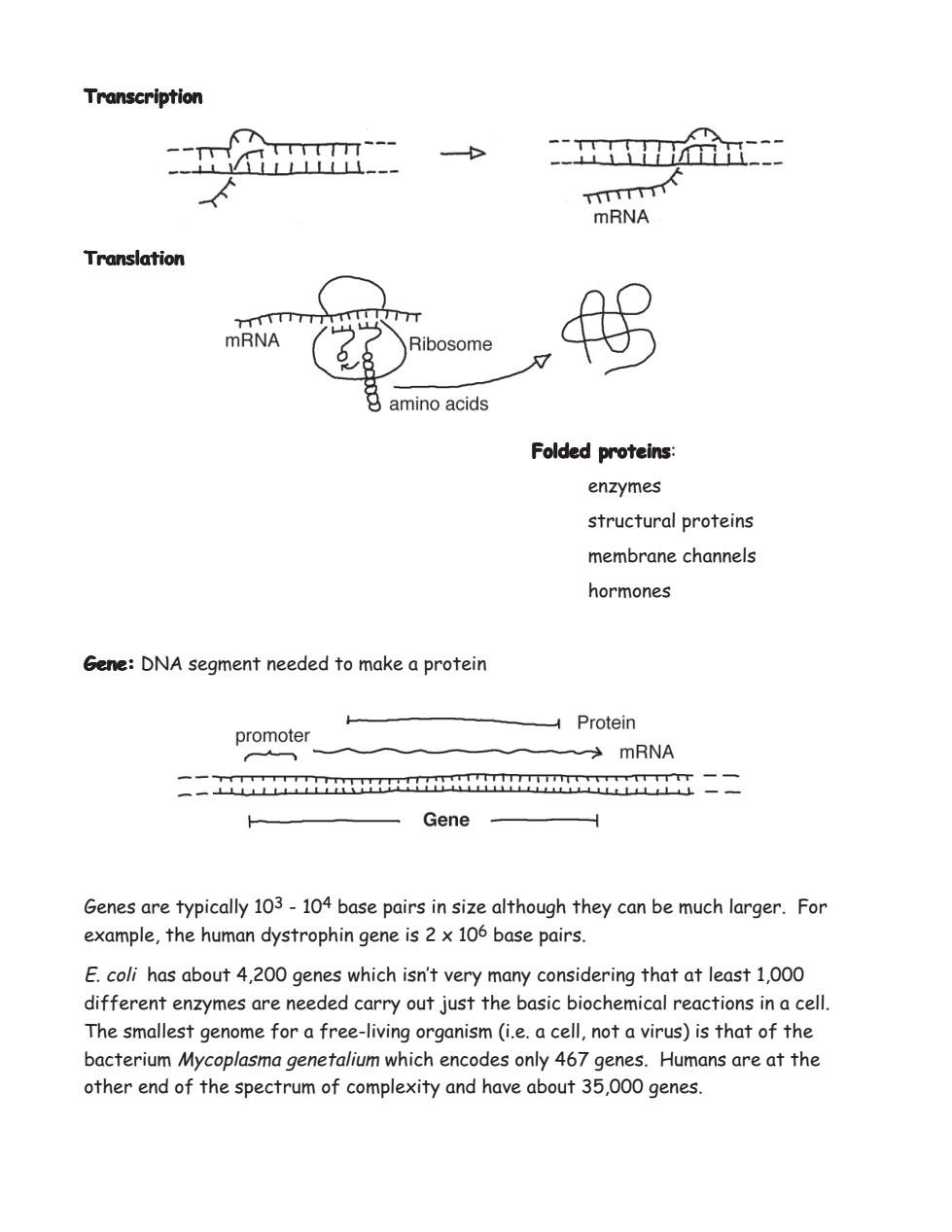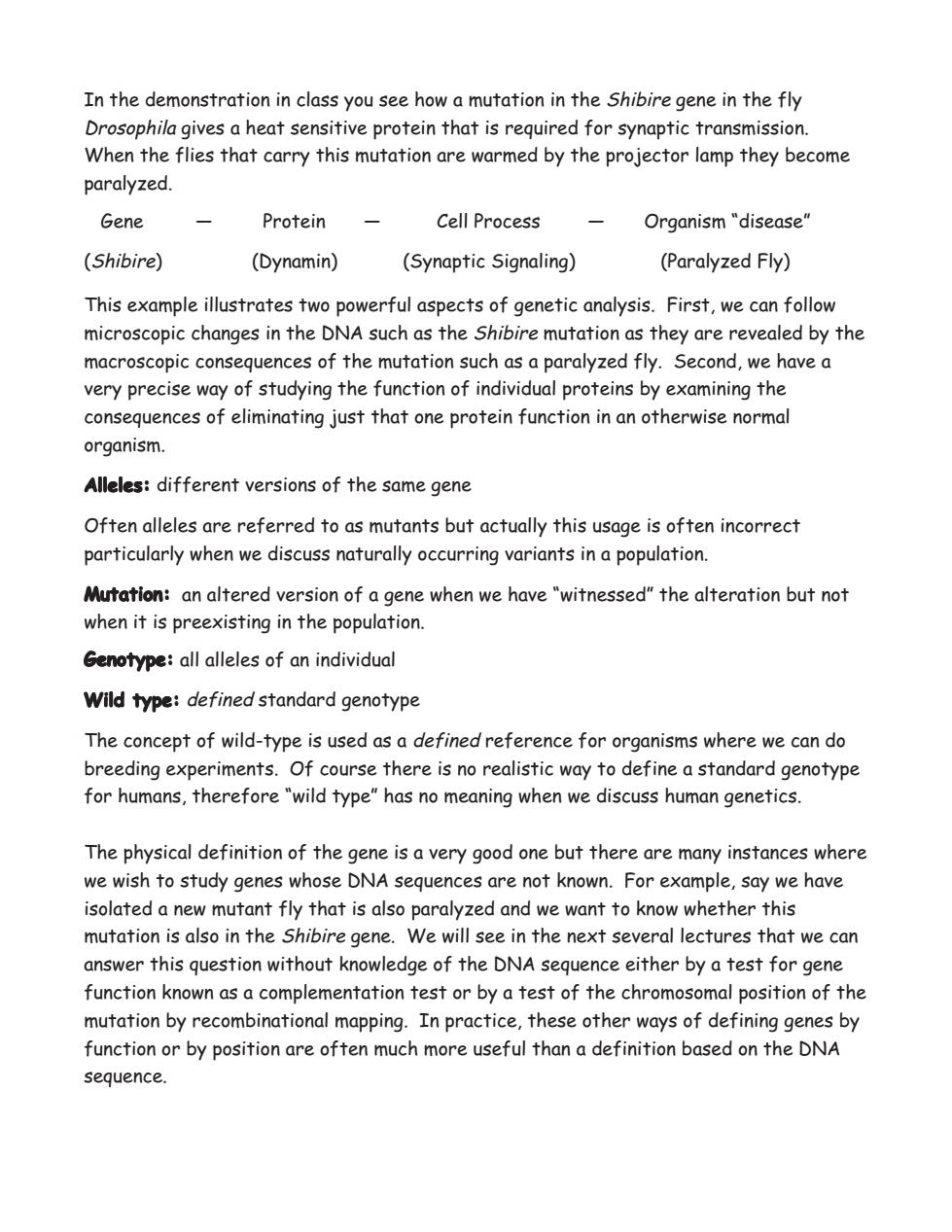
Genetics Lecture 1 We will begin this course with the question:What is a gene? This question will take us four lectures to answer because there are actually several different definitions that are appropriate in different contexts. We will start with a physical definition of the gene.Conceptually this is the simplest and it will give me an excuse to briefly review some of the molecular biology that you probably already know. Genes are made of DNA For this course we will mostly think of DNA as an information molecule not as a chemical substance. T A A T C In 1953,Watson and Crick deduced that the structure of DNA was a double helix.It was not the helical structure per se,but the discovery of complementary base pairing that revealed how information could be encoded in a molecule and how this information could be exactly duplicated each cell division.Replication. G ATC CTAG GAT C CTAG G AT C C TAG In order to extract information from the DNA,the cell again uses the complementary base-pairing to make a copy of the information copied onto an RNA molecule.This is known as Transcription.RNA is chemically less stable than DNA and mRNA can be thought of as a temporary copy of DNA's information
Genetics Lecture 1 We will begin this course with the question: What is a gene? This question will take us four lectures to answer because there are actually several different definitions that are appropriate in different contexts. We will start with a physical definition of the gene. Conceptually this is the simplest and it will give me an excuse to briefly review some of the molecular biology that you probably already know. Genes are made of DNA For this course we will mostly think of DNA as an information molecule not as a chemical substance. In 1953, Watson and Crick deduced that the structure of DNA was a double helix. It was not the helical structure per se, but the discovery of complementary base pairing that revealed how information could be encoded in a molecule and how this information could be exactly duplicated each cell division. Replication. In order to extract information from the DNA, the cell again uses the complementary base-pairing to make a copy of the information copied onto an RNA molecule. This is known as Transcription. RNA is chemically less stable than DNA and mRNA can be thought of as a temporary copy of DNA’s information

Transcription mRNA Translation TTTT六 mRNA Ribosome amino acids Folded proteins: enzymes structural proteins membrane channels hormones Gene:DNA segment needed to make a protein Protein promoter 人 mRNA H二二 Gene Genes are typically 103-104 base pairs in size although they can be much larger.For example,the human dystrophin gene is 2 x 106 base pairs. E.coli has about 4,200 genes which isn't very many considering that at least 1,000 different enzymes are needed carry out just the basic biochemical reactions in a cell. The smallest genome for a free-living organism(i.e.a cell,not a virus)is that of the bacterium Mycoplasma genetalium which encodes only 467 genes.Humans are at the other end of the spectrum of complexity and have about 35,000 genes
Transcription Translation Folded proteins: enzymes structural proteins membrane channels hormones Gene: DNA segment needed to make a protein Genes are typically 103 - 104 base pairs in size although they can be much larger. For example, the human dystrophin gene is 2 x 106 base pairs. E. coli has about 4,200 genes which isn’t very many considering that at least 1,000 different enzymes are needed carry out just the basic biochemical reactions in a cell. The smallest genome for a free-living organism (i.e. a cell, not a virus) is that of the bacterium Mycoplasma genetalium which encodes only 467 genes. Humans are at the other end of the spectrum of complexity and have about 35,000 genes

In the demonstration in class you see how a mutation in the Shibire gene in the fly Drosophila gives a heat sensitive protein that is required for synaptic transmission. When the flies that carry this mutation are warmed by the projector lamp they become paralyzed. Gene Protein Cell Process Organism "disease" (Shibire) (Dynamin) (Synaptic Signaling) (Paralyzed Fly) This example illustrates two powerful aspects of genetic analysis.First,we can follow microscopic changes in the DNA such as the Shibire mutation as they are revealed by the macroscopic consequences of the mutation such as a paralyzed fly.Second,we have a very precise way of studying the function of individual proteins by examining the consequences of eliminating just that one protein function in an otherwise normal organism. Alleles:different versions of the same gene Often alleles are referred to as mutants but actually this usage is often incorrect particularly when we discuss naturally occurring variants in a population. Mutation:an altered version of a gene when we have "witnessed"the alteration but not when it is preexisting in the population. Genotype:all alleles of an individual Wild type:defined standard genotype The concept of wild-type is used as a defined reference for organisms where we can do breeding experiments.Of course there is no realistic way to define a standard genotype for humans,therefore "wild type"has no meaning when we discuss human genetics. The physical definition of the gene is a very good one but there are many instances where we wish to study genes whose DNA sequences are not known.For example,say we have isolated a new mutant fly that is also paralyzed and we want to know whether this mutation is also in the Shibire gene.We will see in the next several lectures that we can answer this question without knowledge of the DNA sequence either by a test for gene function known as a complementation test or by a test of the chromosomal position of the mutation by recombinational mapping.In practice,these other ways of defining genes by function or by position are often much more useful than a definition based on the DNA sequence
In the demonstration in class you see how a mutation in the Shibire gene in the fly Drosophila gives a heat sensitive protein that is required for synaptic transmission. When the flies that carry this mutation are warmed by the projector lamp they become paralyzed. Gene — Protein — Cell Process — Organism “disease” (Shibire) (Dynamin) (Synaptic Signaling) (Paralyzed Fly) This example illustrates two powerful aspects of genetic analysis. First, we can follow microscopic changes in the DNA such as the Shibire mutation as they are revealed by the macroscopic consequences of the mutation such as a paralyzed fly. Second, we have a very precise way of studying the function of individual proteins by examining the consequences of eliminating just that one protein function in an otherwise normal organism. Alleles: Alleles:Alleles: different versions of the same gene Often alleles are referred to as mutants but actually this usage is often incorrect particularly when we discuss naturally occurring variants in a population. Mutation: Mutation:Mutation: an altered version of a gene when we have “witnessed” the alteration but not when it is preexisting in the population. Genotype: Genotype:Genotype: all alleles of an individual Wild type: defined standard genotype The concept of wild-type is used as a defined reference for organisms where we can do breeding experiments. Of course there is no realistic way to define a standard genotype for humans, therefore “wild type” has no meaning when we discuss human genetics. The physical definition of the gene is a very good one but there are many instances where we wish to study genes whose DNA sequences are not known. For example, say we have isolated a new mutant fly that is also paralyzed and we want to know whether this mutation is also in the Shibire gene. We will see in the next several lectures that we can answer this question without knowledge of the DNA sequence either by a test for gene function known as a complementation test or by a test of the chromosomal position of the mutation by recombinational mapping. In practice, these other ways of defining genes by function or by position are often much more useful than a definition based on the DNA sequence